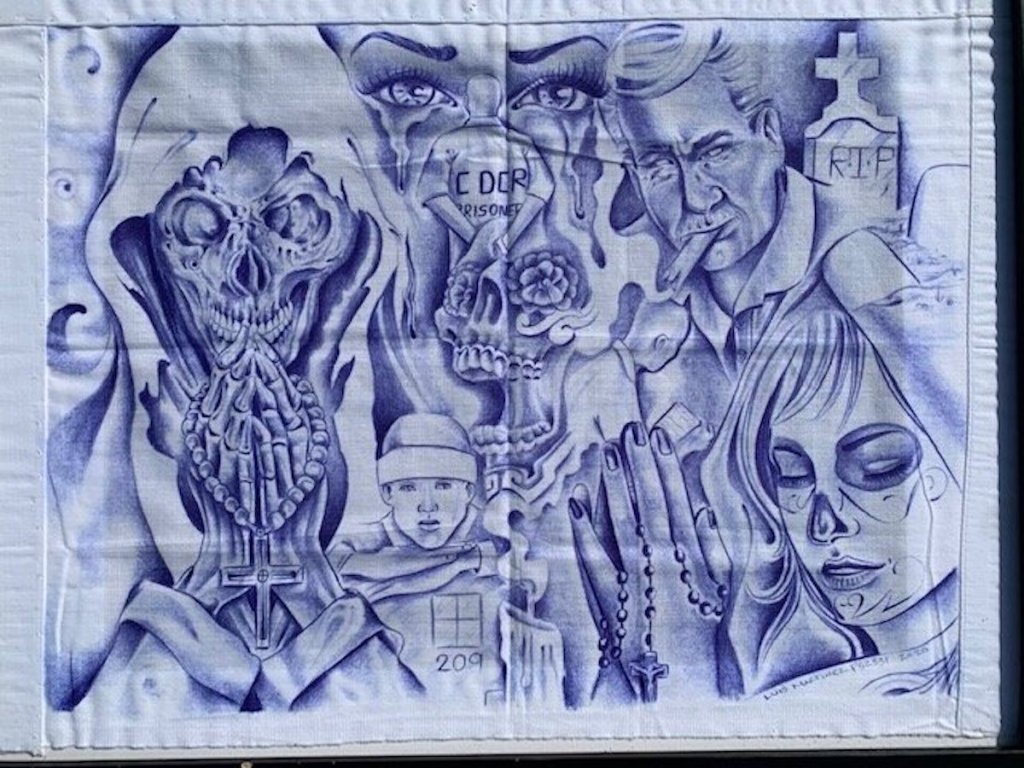The view from behind bars is bleak — windowless rooms, weathered gray concrete, and the harsh echoes of slamming gates — but for those locked in these environments, being surrounded by ugliness can sometimes drive the urge to create beauty. UC Santa Barbara’s Library just opened a unique new exhibit in its Mountain Gallery called Beyond the Wall: The Prison Art Resistance, featuring work that showcases the ingenuity and creativity of those who are currently serving time across the state.
Vickie Vértiz, who teaches creative nonfiction and writing for Chicanx Studies at UCSB, hosted the virtual opening for the exhibition on January 19. Vértiz said she was struck by the “survival, resiliency, and beauty” in the 22 pieces chosen for the show.
Members of UCSB’s Underground Scholars Initiative curated the exhibit, and all work was donated by the artists. Juan Bran-Gudiel, Recruitment Coordinator for the Underground Scholars program, spoke during the opening about the therapeutic value of making art, which can be the only thing that keeps the mind alive behind bars. Unfortunately, Bran-Gudiel added, art supplies and classes are not ordinarily available in jails and prisons.
Almost all art created behind bars is considered contraband, as are the materials necessary to make basic drawings. This lack of resources fosters a MacGyver-esque level of ingenuity among inmates like Francisco Mendoza, whose three-dimensional sculpture “Lowrider Truck” was created out of empty potato-chip bags.
“Santa Muerte,” a painstaking blue ink drawing by Luis Martinez, depicts a detailed collage of Chicano-inspired imagery. Without access to ink, brushes, or canvas, Martinez scrawls his art across cotton bedsheets, using a “shader” made from rolled-up paper.
Getting the work out of prison and into the hands of the Underground Scholars was a process of trial and error. Pieces that took weeks to make were lost in transit, either thrown away or confiscated by custodial staff for their personal collections.
Last year, the Museum of Modern Art in New York presented a similar exhibition, Marking Time: Art in the Age of Mass Incarceration, which ran until April 2021. The MOMA exhibition and the book that accompanied it opened a public discussion about the art made by those living among the two million people incarcerated across the country. Beyond the Wall continues that discussion and showcases how the artistic spirit persists even when so much else is absent.
Sign up for Indy Today to receive fresh news from Independent.com, in your inbox, every morning.
One of the most remarkable works in the show is “Multicolored Frog” by Christopher Avitea. The boldly rendered red-eyed tree frog, with its bright colors popping off against the background of a midnight-blue sky, is even more impressive given that Avitea drew it with inks extracted from old magazines. In a letter to a former cellmate, Avitea described how he taught himself to draw over 40 years, at first picking up the hobby to trade for commissary snacks and to have something to send to his daughters back home.
Avitea developed his skills by drawing every day — primarily animals whose wild nature and relative freedom make a welcome contrast to jail life. Soon, he was receiving commissions weekly. Now nearly 62 years old, Avitea hopes to make amends for his past by donating any potential earnings from his art to nonprofits.
Over four long decades in prison, art has helped Avitea process his trauma and realize his potential. Like many artists featured in the Beyond the Wall exhibition, Avitea uses art to express his personality in an environment that stifles creativity and individuality. Beyond the Wall testifies to the power of art to survive, and even thrive, no matter where or when.
Support the Santa Barbara Independent through a long-term or a single contribution.

